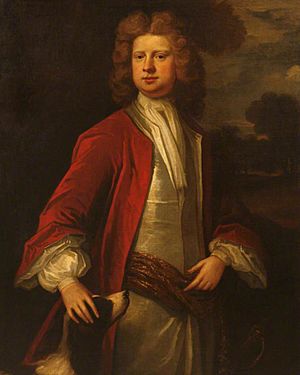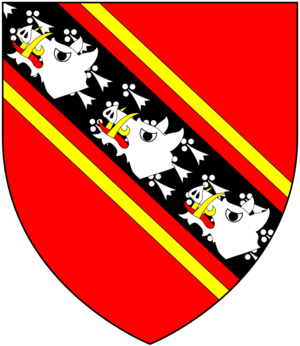Richard Edgcumbe, 1st Baron Edgcumbe facts for kids
Quick facts for kids
Richard Edgcumbe
|
|
|---|---|
 |
|
| Born | 23 April 1680 |
| Died | 22 November 1758 (aged 78) |
| Occupation | Politician |
| Title | 1st Baron Edgecumbe |
| Spouse(s) | Matilda Furnese |
| Children | 3 |
| Parent(s) | Sir Richard Edgcumbe Lady Anne Montagu |
Richard Edgcumbe, 1st Baron Edgcumbe (born 23 April 1680, died 22 November 1758) was an important English politician. He lived at Mount Edgcumbe in Cornwall. He was a member of the Whig political party. Edgcumbe served in the English and British Parliament from 1701 until 1742. In 1742, he was given the noble title of Baron Edgcumbe. A place called Edgecombe County, North Carolina in the United States is named after him.
Contents
Early Life and Family
Richard Edgcumbe was the son of Sir Richard Edgcumbe and Lady Anne Montagu. His mother was the daughter of Edward Montagu, 1st Earl of Sandwich.
When he was 14 years old, in 1694, Richard Edgcumbe inherited his family's estates. This happened after his brother, Piers Edgcumbe, passed away. Richard later studied at Trinity College, Cambridge in 1697. He also traveled abroad in 1699, which was common for young gentlemen at that time.
Political Career
Richard Edgcumbe began his long career in politics in 1701. He was elected as a Member of Parliament (MP) for Cornwall. An MP is a person elected to represent a group of people in the House of Commons, which is part of the British Parliament.
Serving in Parliament
After his first election, Edgcumbe was elected MP for St Germans later in 1701. He then became the MP for Plympton Erle in 1702. He was re-elected for Plympton Erle several times. As a Whig politician, he often supported his party's views. For example, he voted for the Court candidate to be Speaker of the House in 1705.
In 1708, he was re-elected as a Whig MP. He often helped his party by counting votes during important decisions. Even though he was not present for a big vote about a person named Dr. Sacheverell, he was still attacked by a crowd who supported Dr. Sacheverell in Cornwall.
Edgcumbe was elected again in 1710. He was even one of the leaders of a large Whig parade in London, which the government tried to stop. He continued to vote on important issues, like against a bill about French trade in 1713. He was re-elected in 1713 and voted against removing another MP, Richard Steele, from Parliament.
Important Government Roles
In 1715, Richard Edgcumbe was re-elected as MP for Plympton Erle. The next year, in 1716, he was given an important job as a Lord of the Treasury. This role involved managing the country's money. He left this job for a short time in 1717 but was given it back in 1720.
He continued to serve as MP for Plympton Erle after the 1722 election. In 1724, he became the Vice-Treasurer of Ireland, a role he held for many years until 1742. He was also appointed a Privy Councillor for Ireland in 1727. A Privy Councillor is a senior advisor to the King or Queen.
In 1734, Edgcumbe was elected MP for both Plympton Erle and Lostwithiel. He chose to represent Lostwithiel. From 1734 to 1747, he held the position of Lord Warden of the Stannaries. This role involved overseeing the tin mines in Cornwall.
Becoming a Baron
Richard Edgcumbe was elected MP for Plympton Erle again in 1741. He remained an MP until 1742. In that year, he was raised to the peerage, meaning he was given a noble title and became the 1st Baron Edgcumbe. This meant he left his seat in the House of Commons and moved to the House of Lords.
Edgcumbe was a loyal supporter of Sir Robert Walpole, who was a very powerful politician at the time. After becoming a Baron, Edgcumbe continued to hold important positions. He was appointed Lord Lieutenant of Cornwall and Chancellor of the Duchy of Lancaster in 1742. He held both these jobs for the rest of his life.
He also had a military career, becoming a colonel in 1745 and a major-general in 1755. In January 1758, he was appointed Chief Justice in Eyre, north of Trent.
Marriage and Children
Richard Edgcumbe married Matilda Furnese. She was the daughter of Sir Henry Furnese, 1st Baronet. Matilda passed away in 1721.
Together, they had four children, including:
- Henry Edgcumbe, their first son, who sadly died when he was a baby.
- Richard Edgcumbe, 2nd Baron Edgcumbe (1716–1761), who was their eldest son to survive childhood. He became the 2nd Baron Edgcumbe after his father. He never married.
- George Edgcumbe, 1st Earl of Mount Edgcumbe, 3rd Baron Edgcumbe (1720–1795). He became the 3rd Baron Edgcumbe after his brother passed away. In 1789, he was given an even higher noble title and became the Earl of Mount Edgcumbe.



